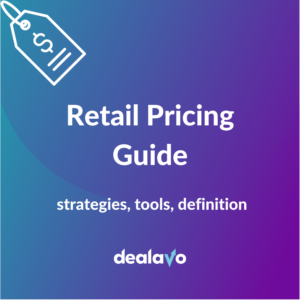
Retail Pricing Guide – strategies, tools, definition
- 21 August 2022
What is retail pricing?
As a retailer perhaps you came across the term “retail pricing”. But what does retail pricing mean?
Simply put, it’s the final price the buyer needs to pay for a product for his own use and without the intention of reselling it for profit. The retail price is a combination of manufacturer price, distribution price, and markup. As a manufacturer can only suggest to you the retailing price (MSRP), it’s in your hand to fix the best price for your product, based on your chosen retail pricing strategy, and as a result – to maximize your profit. Of course, doing it freely and on a whim will not bring you any good. In the end, the main thing is to convince clients to buy your products, by offering them an alluring price, so it needs to be well-poised.
When it comes to pricing sets, there is one more crucial factor to be taken into account – the Retail Price Index (RPI), today also known as the Customer Price Index. We live in a world of a changeable economic situation, where the bull market and the bear market make a cycle. That is why a detailed understanding of occurring economic changes is a must. To meet these market expectations the UK’s government came up with the idea of a long-term monitoring index to follow their citizens’ spending, including a typical basket of goods, household expenses, and leisure expenditures. However, RPI, devised in 1947, became quite outdated and didn’t meet international standards. Therefore, it was replaced by the Customer Price Index which works pretty much the same as RPI, yet provides much more accurate and detailed data regarding ongoing inflation and market demands. In other words – CPI tracks what products people buy for what price. This index consequently gives you a chance to price a product for retail in the most profitable way, according to the newest market situation.
There are plenty of pricing strategies for retailers these days. In this article, we’ll delve into some of them to help you increase your profitability, and conquer your competitors in today’s e-commerce market.
How to price a product for retail?
Before we get into details of how to choose the best pricing strategy, let’s ponder how to actually price a product for retail. Though it may seem an easy task, it’s a key factor to increase profitability and make your retail successful.
As far as the retail price is concerned, it’s commonly accepted that the Recommended Retail Price (RPP) is around 2 to 3 times the trade or wholesale costs, depending on your markup. To make it easier to understand, take a look at the example below.
Let’s say you have a product whose cost price is $10, and the trade price is $20. That means your suggested retail price will hover between $40-$60. The best-recognized practice though is to charge around 2.5 times the distribution price, so in our example, the best retail price is $50.
Also, keep in mind, that when it comes to pricing a product for retail you should take into consideration all of your business costs such as e-commerce platform fees, taxes, transfer fees, and other expenses you need to bear to keep your business profitable.
However, before fixing the margin, remember to analyze the market and check your competitors’ prices first. If you don’t know how to do this properly or which tool to choose, we will present you with the best retail price tracking tools later in the article.
Strategies to increase profitability
Currently, you may find dozens of pricing strategies for retailers available online. Although the issue is, how to choose the best pricing strategy for your shop, and consequently how to increase your profitability. As researching them may be too time-consuming, we chose the top 5 pricing strategies for how to increase your financial efficiency almost immediately.
- Value-based pricing.
Have you been ever wondering why people can pay a fortune just for a scarf, a phone, or a car? It’s not because of its exceptional functionalities (well… maybe sometimes it is). What matters the most is the non-market value the product gives. This pricing strategy is extensively used in the fashion and luxury commodities industry. If your brand is strong, creates a sense of belonging to a particular community, or just fulfills your clients’ craving for an unexceptional experience, you don’t need to worry about the economics or even your competitors. The value of your product is much beyond its actual market price. Great examples are Louis Vuitton, Apple, and Starbucks. - Competitive pricing.
Before building a well-known brand that you can price according to your client’s perceived value, you perhaps will mostly focus on selling. If your inventory consists of popular, easy-available products, it’s very likely you have plenty of competitors. To take the lead, monitoring them is simply a must. In that case, competitive pricing seems to be the most reasonable strategy to choose. That means your pricing will fluctuate according to your competitors’ market moves and changes. Of course, when operated manually, it’s an incredibly time-consuming and error-prone task therefore using a price monitoring tool is highly recommended. A competitive pricing strategy is largely used by Amazon retailers.
Try Dealavo to over smart your competitors. - Cost-plus pricing.
Let’s say that you are just a beginner. You have some stock inventory of physical products that you’d like to sell with a profit, and for now, you don’t have the urge to go into details about pricing strategies. Then definitely go for a cost-plus pricing strategy! You just take the product’s production cost, add a markup, and … done. However, as simple as it is, it’s not an ideal approach, and over time, many drawbacks may show up.
Examples: clothing and grocery stores. - Economy pricing.
Dealing with volume-based stock though requires a different perspective, especially when it comes to low-cost products. Economy pricing should work well here. How to price a product for retail employing an economy pricing strategy? It’s simple – you just keep selling products for a small profit and give your consumers a feeling of getting a bargain. This strategy is recommended to retailers who deal with price-sensitive clients, e.x. in the pharmaceutical industry. - Dynamic pricing.
Finally – a perfect match for e-commerce! Running a brick-and-mortar shop is not as exposed to market rapid changes as an online business is. For many e-sellers time is money, and by “time” we mean “seconds”. While buying online what matters the most is the price – customers usually use price comparison websites to choose the cheapest retailer. In that case, even a few cents may make a difference and bring a profit or a loss. There are a few variables that have an impact on price fluctuations, yet competitors’ pricing is both the most common, and the most important one.
Do you want to stay ahead of your competitors and win the e-commerce market? Try out Dealavo’s Dynamic Pricing features and don’t be troubled by rapid price changes anymore.
Retail Price Tracking Tools
What Is Retail Price Monitoring Software?
Retail Price Monitoring Software allows for an in-depth analysis of historical and real-time competitors’ pricing situations and strategies. The price-tracking platform studies your competition or products, providing you with the data that allows for your pricing strategy optimization. The platform should allow for tracking the pricing strategy of your business, price monitoring across channels, and spotting MAP/MSRP violations. The high-quality tool analyses the price fluctuations in e-commerce shops, marketplaces, and many more
How Does Retail Price Monitoring Help with the Business?
In today’s hectic market, every business needs a tool or a platform that generates reliable data sets to stand out from competitors. Moreover, observing your competitors’ moves allows you to make the best money-making decisions, as well as choose the best pricing strategy. Retail price monitoring tools provide reliable, automatic, and human-error-free data, that will give you great opportunities to evaluate and grow your business, by staying competitive. By using the retail price monitoring software you obtain access to daily up-to-date reports, that let you react immediately to current market changes.
What Are the Top 8 Retail Price Monitoring Tools?
The offer of retail price monitoring tools is growing, so retailers may find it problematic to choose the best software, tailored to their needs. For that reason, we prepare a short comparison of the top 8 Retails Price Monitoring Tools, to save time and money for our readers.
Dealavo
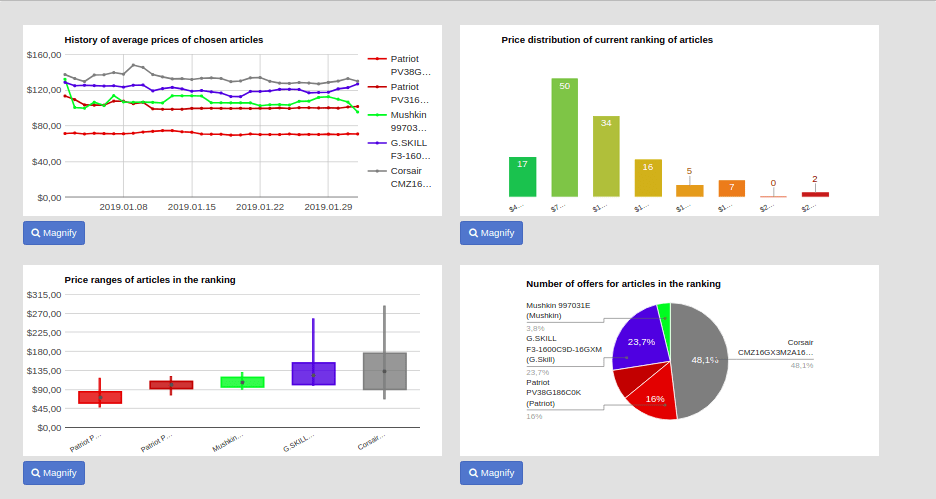
Price Monitoring for Brands and E-shops with Dynamic Pricing Feature. Source: dealavo.com
Dealavo is a price monitoring tool that certainly distinguishes itself from other pricing monitoring software providers. It’s designed for brands and e-shops and combined with advisory services, such as Dynamic Pricing.
Dealavo platform allows brands to monitor the prices of their products across channels and quickly spot MAP/MSRP violations in e-shops, marketplaces, and price comparison websites worldwide.
With Dealavo you will easily track the implementation of your pricing strategy by key channel partners and act on any possible violations. Aggregated data allows you to benchmark your channels and helps you choose the best partners for future cooperation.
Pros:
- free trial version,
- many useful integrations,
- Dynamic Pricing feature,
- twofold structure – for brands and e-shops,
- full customer success support.
Cons:
- complicated admin panel,
- some features may perform slowly.
Source:
- https://www.capterra.com/p/197117/Dealavo/
- https://www.g2.com/products/dealavo/reviews
Price2Spy
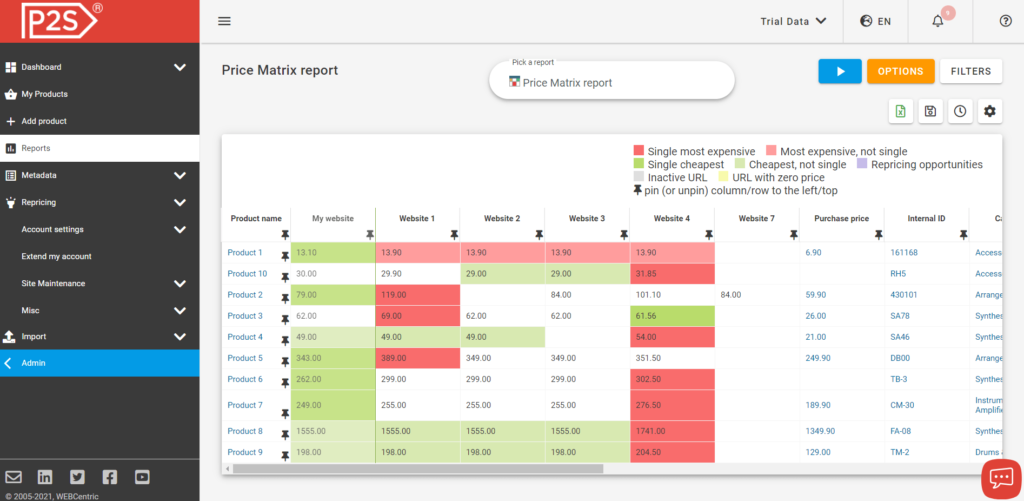
Price2Spy is a price monitoring, comparison, and repricing tool. Source: g2.com
As a retail pricing application, Price2Spy relies on Machine Learning and Artificial Intelligence. Consequently, it helps various professionals to break down pricing analyses and attain desirable results. The software is designed to monitor all kinds of websites, even those with a built-in anti-tracking shield. One of the main Price2Spy’s pros is the fact that the software provides you with demos, tutorials, and online support. However, some reports from the app may be harder to comprehend.
Pros:
- easy to use – no technical skills required,
- both manual and automated repricing options,
- free trial,
- various integrations.
Cons:
- not all features are fully automated,
- deficient reports interface.
Source:
- https://www.capterra.com/p/154047/Price2Spy/
- https://www.g2.com/products/price2spy/reviews
PriceGrid

PriceGrid provides businesses with a competitive price analysis. Source: pricegrid.com
Located in the U.S., PriceGrid is a Cloud-based price monitoring software, that operates on a SaaS license. PriceGrid’s strategy is based on simplifying, monitoring, analyzing, and competing. With the supportive and knowledgeable helpdesk, this software’s only drawback is perhaps a lack of a free trial. Undoubtedly, one of the most distinctive features of this software is researching prices in seconds.
Pros:
- user-friendly and intuitive,
- reasonable price,
Cons:
- no free trial,
- lack of depth-in reports.
Source:
- https://www.g2.com/products/pricegrid/reviews
- https://www.capterra.com/p/213738/PriceGrid/
See how Dealavo compares with PriceGrid
Zilliant
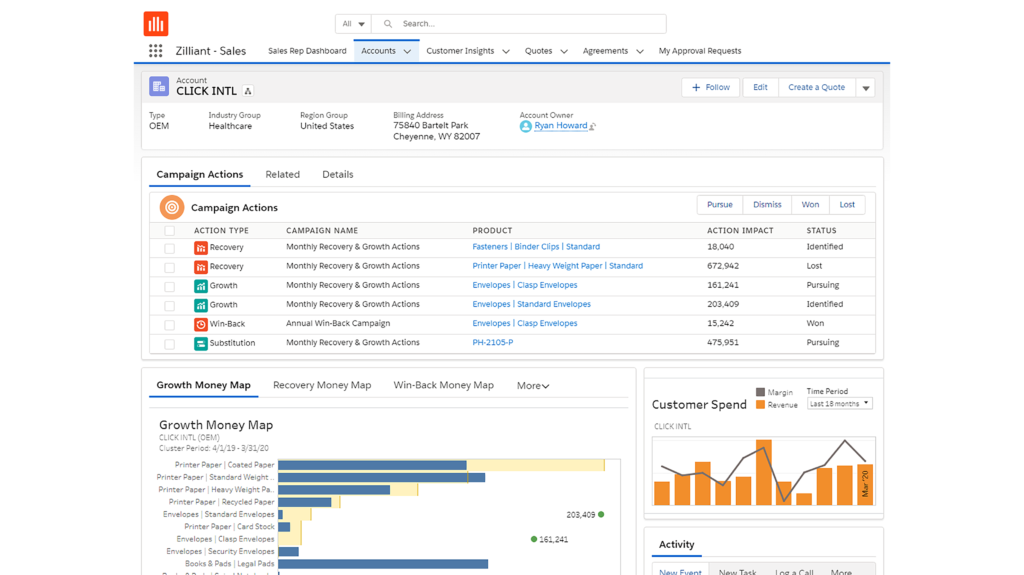
Zilliant connects strategy to execution and transforms how you use data to price and sell. Source: zilliant.com
Deploying commercial strategies and using data more intelligently is at the core of Zilliant’s service. The app’s solution set consists of several platforms: Zilliant IQ, Price IQ, Price Manager, Sales, Deal Manager, IQ, Cart IQ, and Sales Planner. This original structure provides more complex and operative insight into pricing modeling. However, Zilliant’s con can be the fact that it may get confusing at times.
The software is dedicated to B2B clients only.
Pros:
- plenty of usefull features,
- displaing prices in a real time,
- omnichanel approach.
Cons:
- challenging admin panel,
- not visually appealing,
- works pretty slow when managing the larger amounts of data,
- B2B solutions only.
Source:
- https://www.capterra.com/p/65748/Zilliant-IQ/
- https://www.g2.com/products/zilliant/reviews
See Dealavo vs Zilliant comparison page
Feedvisor

Feedvisor – AI optimization and intelligence platforms. Source: g2.com
Feedvisor can provide optimization when it comes to the most popular sellers, such as Amazon or Walmart. Among its features are 3P Storefront Launch and Management, Advertising and Marketing Strategy and Management, Content Listing Optimisation, Reputation Management, and Marketplace Cleaning. AI technology implemented into Feedvisor’s solutions is smoothly combined with Amazon’s expertise. The only concern is about the fact that margins are not that accurate all the time and may be higher than in reality. However, a free trial is provided.
Pros:
- omnichannel-oriented,
- best for Amazon sellers thanks to tight integrations,
- free trial,
- easy to set up,
- rich variety of features.
Cons:
- inflexible functionalities,
- pretty pricey.
Source:
- https://www.g2.com/products/feedvisor/reviews
- https://www.capterra.com/p/173811/Feedvisor/
Check: Feedvisor vs Dealavo as an alternative tool
BlackCurve
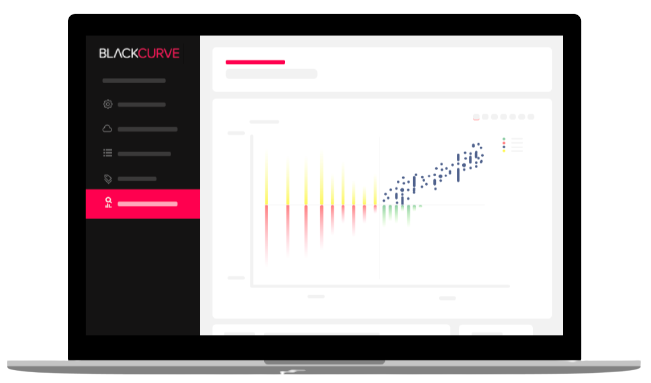
BlackCurve allows you to track your competitors daily with Google Shopping price monitoring. Source: g2.com
Black Curve’s focus is on e-commerce businesses that seek to get to know their competitors. Google Shopping Price Monitoring is often employed by Black Curve, followed by a Google Ads campaign based on a market position. Thanks to BlackCurve Dynamic Pricing Technology, retailers may track hundreds and thousands of SKUs daily.
However, the admin panel is sometimes said to have a minor malfunction.
Pros:
- helpful technical support,
- manages to process even very complex data,
- advanced Dynamic Pricing Technology.
Cons:
- admin panel needs some UI improvement,
- technical support is available via e-mail only.
Source:
- https://www.capterra.com/p/155996/BlackCurve/
- https://www.g2.com/products/blackcurve/reviews
BlackCurve vs Dealavo – what are the differences
DataWeave
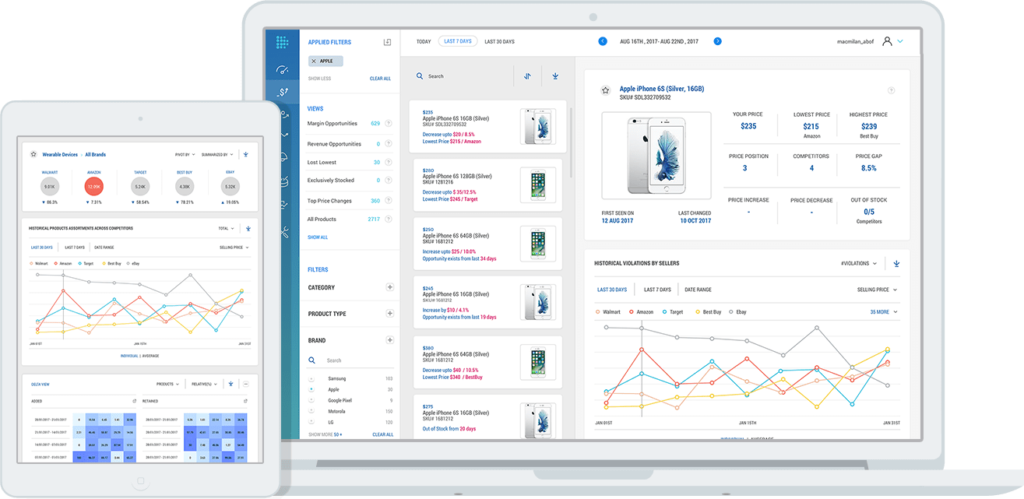
DataWeave is a SaaS-based digital commerce platform providing digital shelf analytics and dynamic pricing solutions for global consumer brands and retailers. Source: g2.com
DataWeave is based on SaaS and centralized around digital commerce. Its primary goal is to accelerate sales growth. Among the software’s most unique capabilities are content quality, price competitiveness, benchmarking, promotion performance, rating, and review analysis. Most importantly, the tool is language-agnostic, which greatly contributes to servicing international markets. Besides that, the interface is described as very user-friendly. However, some challenges also arise – such as a limited number of price update circles.
Pros:
- provides depth-in reports,
- user-friendly,
Cons:
- pricing plans are available only upon request,
- some data may not be accurate and requires manual double-checking.
Source:
- https://www.g2.com/products/dataweave/reviews
- https://www.capterra.com/p/188068/Competitive-Intelligence-Platform/
Dataweave alternatives – Dealavo
Skuuudle
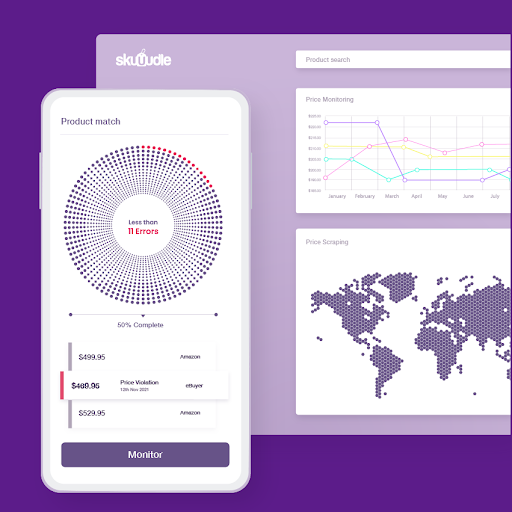
Skuuudle can track prices, discounts, product images, availability, reviews, and more. Source: g2.com
Thanks to the fact that Skuuudle cooperates with both smaller businesses and huge enterprises, the software delivers targeted pricing. What are the other features of the tool, though? It is based on 6 pillars: Data Collection, Product Matching, Quality Control, Easy-to-use Analytics, Cloud-based, First Class Support, which is supposed to help you stay ahead of the competition. Skuuudle is a synonym for Pricing Intelligence. At times, however, multi-listing issues (connected with, eg, eBay) may appear.
Pros:
- reasonable pricing,
- an impressive amount of shared data,
- accurate and up-to-date data & customized reports.
Cons:
- dashboard requires minor improvements,
- prone to bugs when it comes to integrations with some platforms (e.x. eBay).
Source:
- https://www.g2.com/products/skuuudle/reviews
- https://www.capterra.com/p/171527/Skuuudle/
Skuudle compares with Dealavo – see their feature comparison
Summary
Pricing product for retails requires detailed preparations and cannot be made at a guess. Properly fixed prices not only increase your profitability, but most importantly may help you win over your competitors, and put you at the forefront.
To improve your sales results you can use plenty of tools, but certainly, the most reliable one is Retail Price Tracking Software. With a help of a price checker, you will be able to observe and anticipate the moves of your competitors, make the best profit-making decisions and stay competitive thanks to daily data updates.
The tools mentioned in the article will surely contribute to implementing the most profitable retail pricing strategies. However, thanks to its advanced features and outstanding customer success support, Dealavo seems to be the most universal price tracking software for retail businesses. Try out our demo version by clicking here.
Finally, the last question remains – are you ready to price your products for retail?